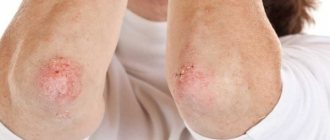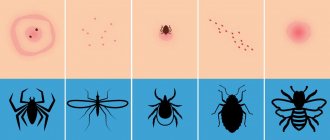What is pityriasis rosea?
Pityriasis rosea is a disease that is diagnosed in children and adults, but more often occurs in young people. The causative agent of the disease is unknown, but there is an assumption that the disease occurs as a result of the penetration of a virus into the body. Most often, skin ailments occur in the off-season (spring and autumn), when the immune system is weakened and the risk of catching a cold is increased.
Inflammation can go away on its own with complete disappearance of symptoms, and then in most cases the patient develops immunity to the disease. But if pityriasis rosea does not go away, then it becomes chronic. And then not just treatment is required, but the development of a special program to prevent frequent relapses and strengthen the patient’s immunity.
Is pityriasis rosea contagious or not, transmitted from person to person or not?
There are several assumptions about how a person can become infected with this disease:
- transmission from person to person by airborne droplets, but with strong immunity this is impossible;
- pityriasis rosea can occur as a result of the body's reaction to hypothermia (this is why the disease often occurs in spring and autumn);
- severe stress, prolonged nervous tension and other factors that undermine the body's defenses can also trigger pityriasis rosea.
Pityriasis rosea and pregnancy
In pregnant women, pityriasis rosea can occur both when a virus enters the body and when there is a tendency to allergic reactions. An “interesting situation” causes a loss of strength, vitamin deficiency, fatigue, hormonal changes, which leads to a decrease in immunity, which means there is a risk of “catching” an infection.
What does pityriasis rosea look like in pregnant women? Exactly the same as in other patients, only treatment in this case is selected even more carefully - taking into account the patient’s condition and the duration of pregnancy.
In young children and newborns, cases of infection are extremely rare. Children's pityriasis rosea often occurs in adolescence, when the hormonal system undergoes restructuring. If pityriasis rosea is diagnosed in a baby in infancy or up to one and 2–3 years of age (the rash spreads throughout the body), then the causes are often intestinal or other past infections, and in rare cases, vaccinations.
Complications after pityriasis rosea, and why it reappears
Relapses of the disease occur rarely or never, but under different circumstances complications such as folliculitis, osteofolliculitis, eczema, streptococcal impetigo, etc. are possible.
Recurrence of the disease is possible when wearing tight clothing, frequent rubbing of the skin during water procedures, incorrect and illiterate treatment of an individual tendency to allergies and excessive sweating.
Secondary infection is manifested by rashes on areas of the skin that are subject to stretching to the greatest extent (along Langer's lines). Especially a lot of flaky spots appear in the groin area and on the inner thighs, as well as on the forearms.
Secondary infection is also possible in places where there are many sweat glands and on delicate areas of the skin. The face is rarely affected; the scalp and mucous membranes also remain clean.
Signs
Having common characteristics in the first stages, in further development they acquire specific characteristics inherent in their species. How to identify lichen by the first signs? What are the signs of different types of lichen?
Pink, ringworm and shingles are contagious in the initial and subsequent stages of their development. To prevent the spread of the disease, it is necessary to limit contact with patients as much as possible and carry out disinfection measures.
They manifest themselves in the form of inflammation, a rash with defined boundaries, peeling and itching. Skin changes color and may cause pain.
Read here: Shingles: types, manifestations, symptoms and treatment. 110 photos and videos of lichen processing and treatment
A photo of a patient with this type of lichen shows enlarged lymph nodes with the presence of characteristic pale pink spots, which is a distinctive sign of its appearance in children. All these types can reduce a person’s immunity and affect his appearance.
Pityriasis rosea: symptoms
The main symptom is pink, scaly spots that appear gradually. The disease begins with the appearance of one spot (maternal plaque) measuring 2 cm. After about a week, multiple pink spots of different diameters appear (smaller than the maternal plaque).
Location of rashes: pityriasis rosea appears on the face and other areas of the skin (sides of the body, back, shoulders, etc.). Peeling appears in the center, and a red border remains around the circumference. Individual spots may merge with each other. Patients may also be bothered by itching of varying intensity and increased body temperature (in cases with complications).
Sometimes pityriasis rosea has atypical forms with symptoms such as blistering, dotted and draining rashes in small quantities, but the spots can reach large sizes and also become chronic.
Pityriasis rosea: causes
As mentioned above, the causes of the disease are not fully understood. Perhaps it is a viral disease; pathogens like herpes are sometimes cited as the cause.
What else causes pityriasis rosea?
As a rule, this is a standard set of reasons that lead to a decrease in immunity and disruption of the normal functioning of the body’s protective functions, namely:
- past infections and diseases;
- colds;
- diseases of the gastrointestinal tract and endocrine system;
- stress and nervous tension;
- change of climate and time zone;
- allergic reactions;
- metabolic disease;
- insect bites, etc.
The medical department provides comprehensive diagnosis and treatment of skin diseases of various levels of complexity and causes. For diagnosis and treatment, dermatologists use specialized expert clinical and clinical-biochemical microscopy, as well as dermatoscopy and cultural diagnostics.
Initial appointment
Treatment of pityriasis rosea in children and adults begins with the first consultation with a specialist. As a rule, already at the first examination, the doctor can make a diagnosis and prescribe a course of treatment with a plan of individual visits according to each specific clinical case.
If the disease is severe or has complications and concurrent infections, then appropriate tests and examinations are prescribed.
Diagnostics
Diagnostics includes:
- examination of the patient by a dermatologist;
- taking material for biopsy and histological examination to exclude parapsoriasis;
- scraping for bacteriological culture;
- scraping for pathogenic fungi;
- fluorescent diagnostics;
- conducting RPR tests for syphilis (in rare cases).
Repeated appointment
The main means of treating pityriasis rosea, its causes and consequences are ointments, gels and creams. But besides this (depending on the case) the patient:
- bathing is prohibited (only washing in the shower with gentle detergents is possible);
- It is advised to limit your time in the sun;
- It is advised to wear loose clothing made from natural materials;
- a hypoallergenic diet is prescribed during treatment and for some time after it;
- prescribe the use of antiallergic and anti-inflammatory ointments for severe itching;
- antibiotics are prescribed (in particularly difficult cases).
Since pityriasis rosea looks like an unpleasant and unaesthetic skin reaction, and can be contagious, it creates psychological discomfort in the patient. A common reaction to any skin rash is a reluctance to leave the house and communicate with people, embarrassment when communicating, isolation and detachment. Accordingly, if necessary, consultations with a psychotherapist or psychologist may be prescribed during treatment. If a dermatologist suspects a hormonal imbalance, an endocrinologist will also conduct a consultation.
If treatment of pityriasis rosea in an adult or child with ointments and other means has already been prescribed, then at a second appointment the doctor evaluates the results. If no improvement is observed, then a new course of treatment and restorative procedures are selected to strengthen the immune system.
Treatment of pityriasis rosea in children depends on the age of the child, his condition and the stage of development of the disease. Means and methods of combating the disease are also selected individually, but the treatment regimen is similar to that for adult patients. As a rule, a child recovers from a disease several times faster than an adult.
Control reception
A follow-up appointment is required 21–30 days after treatment to assess the patient’s condition and treatment results. If the outcome is positive, methods of restoring the patient are prescribed (physiotherapy, immunotherapy, etc.).
Treatment result
Achieving positive results is only possible if you strictly follow the doctor’s recommendations and prescriptions. The duration of treatment is also individual in each case and is discussed with the doctor at the appointment: treatment usually takes from 2 to 6 weeks. If the patient has excessive sweating or allergic reactions, the treatment period is increased.
Prevention
To avoid the need to treat pityriasis rosea in a person, he should be warned: with what and how?
Good prevention is:
- proper nutrition or a hypoallergenic diet if you are prone to allergic reactions;
- strengthening the immune system through sports and active recreation;
- wearing high-quality clothes made from natural materials;
- individual selection of cosmetics and care products for body and face;
- local therapy, including taking medications to strengthen the immune system;
- careful use of water procedures;
- wearing warm clothes in the off-season and cold season to avoid hypothermia.
Making a diagnosis on your own is not recommended, nor is it recommended to prescribe treatment on your own. How and with what to treat and cure pityriasis rosea, get rid of symptoms and prevent the causes of relapses, only a dermatologist
. So don't delay visiting your doctor. High-quality and timely prescription of a course of treatment will allow you to quickly get rid of the disease and significantly improve your quality of life.
To make an appointment with a dermatologist in our center, just leave a request on the website (there is a special registration form) or call the phone number listed on the page.
Treatment methods
Treatment of microsporia takes about 3 weeks and includes oral administration of antifungal drugs, daily shaving of hair in areas of the disease, and treatment of affected areas of the body with special ointments. In this case, the patient is isolated, since the disease is contagious. As an additional method of treating trichophytosis, X-ray therapy can be used - irradiation of the source of the disease with X-rays. Before the procedure, pre-treatment of the affected areas is carried out - flakes of exfoliating skin are removed from them. After the procedure, the affected area is lubricated with tar or salicylic ointment.
Ringworm can be effectively treated, and the best results are achieved by combining several treatment methods simultaneously. In advanced cases, the disease can, unfortunately, lead to partial baldness or uneven hair growth in the affected areas, even after the fungus is completely eliminated from the skin.
We deprive hygiene when sick
It is believed that lichen resulting from influenza, acute respiratory viral infections, and colds can be infectious. Therefore, household members need to strictly adhere to the rules of personal hygiene and have personal items (your own towel, comb, bedding). Although there are not so many cases when the symptoms of allergic lichen appear immediately in the whole family. Only when everyone had a weakened immune system. Ringworm caused by a stressful situation is not transmitted.
Diagnosis of the disease
To make a correct diagnosis, the doctor only needs to carry out several diagnostic measures:
- Examine the patient's skin for the presence of a rash characteristic of microsporia.
- Take a scraping of the skin and examine it for the presence of fungus under a microscope.
- Identify the type of pathogen through bacteriological culture.
- Using a Wood's lamp, determine the presence of fungus on the skin (the mycelium turns green under the influence of the device).
Question answer
Which healthcare workers can treat fungus?
This type of disease in children is treated by a pediatrician. Adult patients can be treated by a general practitioner or family medicine specialist, as well as a dermatologist. An infected person can contact primary health care providers for medical care. If the infection is complicated by suppuration, then it is better to go for examination to an infectious disease specialist.
How long does it take to treat ringworm?
It all depends on the severity of the disease. If the disease is not advanced, it is completely cured within 1 - 2 months. In infiltrative-suppurative forms, the patient’s recovery takes up to six months.
Is it possible to prevent fungal disease in children?
To do this, you and your children just need to follow the following rules:
- Do not use other people's hygiene items (soap, washcloth, towel).
- Do not wear other people's hats, clothes and shoes.
- If your pet has shingles, do not handle it without gloves.
- Wear rubber sandals in the pool, and do not stand barefoot on the floor in shared showers and locker rooms.
- Never wear wet or too tight shoes.
Why can’t you just use ointments for ringworm?
This form of fungus (dermatophytes) is resistant to local treatment, so only the initial stages of the disease can be cured with ointments (it is characterized by peeling and redness). If severely inflamed, swollen foci of infection begin to spread across the skin, then you cannot do without pills. Medicines penetrate through the blood into places where the fungus accumulates and kill it.
Is there a specific skin care regimen for ringworm?
You can improve the condition of skin affected by fungus by following the following daily steps:
- Wash your hair with Naftaderm or Betadine antifungal shampoo as often as possible.”
- Immediately after washing, treat sore skin with 5% iodine.
- In the morning after sleep and at night, apply Clotrimazole ointment to the spots.
How should a person infected with ringworm eat?
The patient's menu should contain products that can support immunity. This includes a variety of fresh vegetables and fruits, chicken, beef, and dairy products. The patient should give up alcohol, coffee, chocolate, spicy and too fatty foods.
Causative agents of pathology
People over 40 years of age are at risk. This is due to the fact that immunity decreases at this age. In addition, this age category has some chronic diseases or is susceptible to stress. These are precisely the factors that reduce the body’s resistance to the effects of pathogens.
Children are a separate category because of their pathological love for homeless animals, which most often act as carriers of lichen pathogens. It is also worth remembering that taking antibiotics and antihistamines significantly reduce children's immunity.
The causative agents of the pathology are fungi and viruses, the carriers of which are other people and animals. Before determining lichen, the doctor will definitely take an interest in the patient’s environment, living conditions and nutrition. These are only minor factors that affect immunity. There are a number of pathogens that provoke infection of a healthy person:
• Fungi are zooanthropophilic. Carriers are most often domestic animals.
• Geophilic mushrooms. Found on the surface of the earth, infection occurs upon contact with the ground. This means working in the garden beds, picking wild berries, mushrooms, and dead wood.
• Anthropophilic fungi affect the surface of the skin and are transmitted by contact with a human carrier.
In humans, each type of lichen manifests itself after exposure to a specific pathogen. This is determined by laboratory tests, visual medical examination and based on how the disease manifests itself in a person exposed to infection. It is important to understand that carriers do not always exhibit characteristic symptoms. Infection occurs when the immune system is weakened. This is another reason that should force you to lead a healthy lifestyle, give up bad habits and control the quality of the foods you eat.










